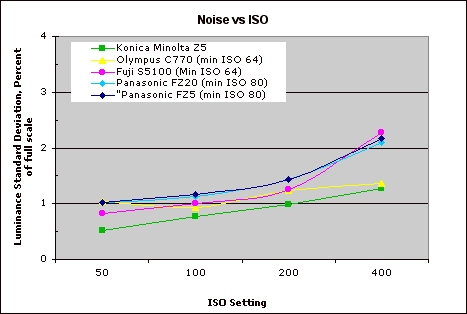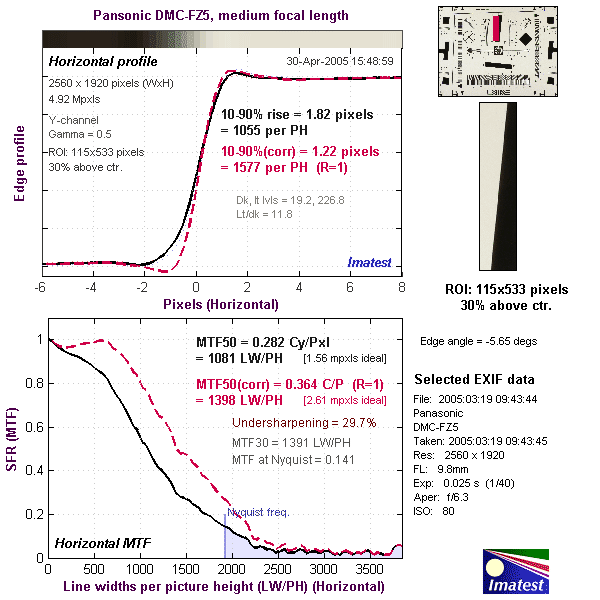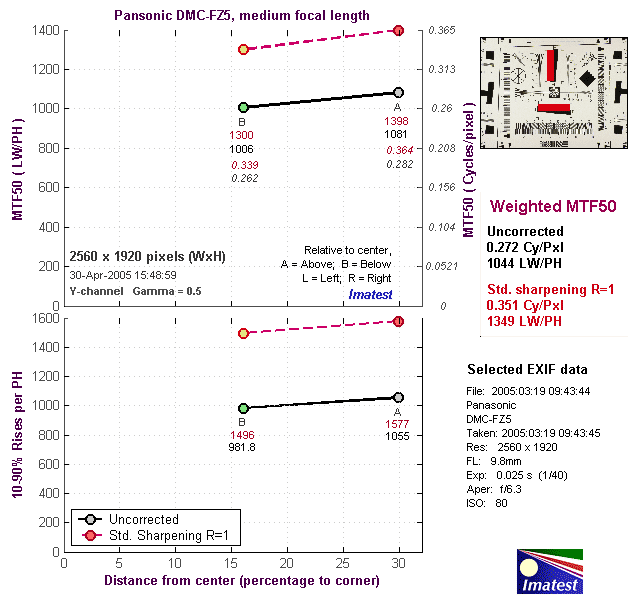Panasonic Lumix DMC-FZ5By: Dave EtchellsPanasonic updates its 12x optically stabilized Leica lens digicam to five megapixels. <<DMC-FZ5 Sample Images :(Previous) | (Next): Print-Friendly Review Version>> DMC-FZ5 Imatest ResultsReview First Posted: 05/09/2005 |
Detailed analysis of the Panasonic DMC-FZ5 images, from Imatest(tm)
I've recently begun using Norman Koren's excellent "Imatest" analysis program for quantitative, thoroughly objective analysis of digicam test images. I highly commend it to our technically-oriented readers, as it's far and away the best, most comprehensive analysis program I've found to date.
My comments below are just brief observations of what I see in the Imatest results. A full discussion of all the data Imatest produces is really beyond the scope of this review: Visit the Imatest web site for a full discussion of what the program measures, how it performs its computations, and how to interpret its output.
Here's some of the results produced by Imatest for the Panasonic FZ5:
Color Accuracy
The Panasonic DMC-FZ5 generally showed very good color accuracy. Strong additive primary colors (red, green, blue) were all somewhat oversaturated, but pretty hue-accurate. Other, less-saturated colors were rendered very accurately. (A fair bit better than average.) Average saturation was 113.9% (oversaturated by 13.9%, mostly in the reds, less so in the greens and blues), average "delta-E" color error was 5.84.
Color Analysis
These images show the color behavior of the FZ5 directly. In each color swatch, the outer perimeter shows the color as actually captured by the camera, the inner square shows the color after correcting for the luminance of the photographed chart (as determined by a 2nd-order curve fit to the values of the gray swatches), and the small rectangle inside the inner square shows what the color should actually be, based on perfect rendering to the sRGB color space.
Gray Patch Tone and Noise Analysis

There's a lot in this particular graph, a lot more than I have room to go into here. Bottom line, the Panasonic FZ5's noise levels are a bit higher than average, and the noise spectrum is such that the noise is has a bit coarser character to it than the best of its competitors.

This chart compares the Panasonic FZ5's noise performance over a range of ISOs against that of other cameras. As you can see, the FZ5's noise levels are a little high relative to those of most of its competitors across the ISO range. What isn't shown here though, is the "grain" structure of the camera nor the extent to which it trades away fine detail as the ISO is increased. The FZ5's noise is a little coarser-grained than the best of its competition, but it does manage to avoid trading away as much subtle subject detail as some of the cameras shown here as having lower noise levels.
The chart above shows consolidated results from spatial frequency response measurements in both the horizontal and vertical axes. The "MTF 50" numbers tend to correlate best with visual perceptions of sharpness, so those are what I focus on here. The uncorrected resolution figures are 1006 line widths per picture height in the horizontal direction (corresponding to the vertically-oriented edge), and 1081 along the vertical axis (corresponding to the horizontally-oriented edge), for a combined average of 1044 LW/PH. Correcting to a "standardized" sharpening with a one-pixel radius increases this number a lot, to an average of 1349 LW/PH. The uncorrected numbers are on the low side for a 5-megapixel camera, the corrected ones are fairly good. (This highlights the fact that you'll get the best resolution from the FZ5 by shooting with the camera's sharpening set to its lowest value, and then sharpening the images post-capture in Photoshop or some other imaging program.)
For the real techno-geeks, the two plots below show the actual edge response of the Panasonic FZ5, for horizontal and vertical edges. (Here, you can see the overshoot caused by the sharpening algorithm, and the extent to which it is reduced by Imatest's correction to a "standard" 1-pixel edge sharpening, as well as the very slight clipping in the blacks. The clipping appears as the very slight flattening on the bottom of the black curves, at their lowest points.)




Follow Imaging Resource: